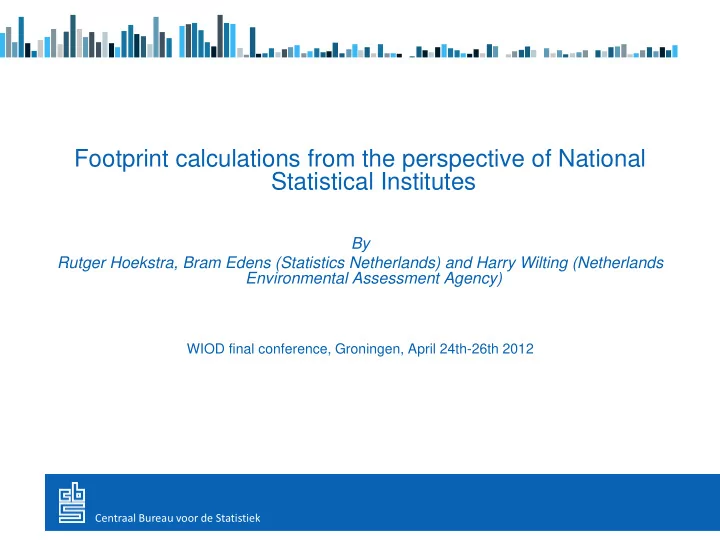

Footprint calculations from the perspective of National Statistical Institutes By Rutger Hoekstra, Bram Edens (Statistics Netherlands) and Harry Wilting (Netherlands Environmental Assessment Agency) WIOD final conference, Groningen, April 24th-26th 2012 Centraal Bureau voor de Statistiek
Introduction • MRIO based calculations – Footprint calculations – Production vs. Consumption perspective – Global shifts in environmental pressures • Will National Statistical Institutes start to produce these MRIO-based footprints? • Bridging the gap between academic and statistical work – Overview of NSI work – Overview of MRIO databases – Differences production of NSI and MRIO data – Potential future problems • Work at Statistics Netherlands/Netherlands Environmental Assessment Agency Centraal Bureau voor de Statistiek
Overview of NSI work Institute Country Type Most recent year Environmental Regions Industries Statistics Canada Canada MRIO 2002 and 2006 GHG 4 ? Statistics Denmark Denmark Partial 2005 CO 2 13 60 Eurostat Eurostat SRIO 2000-2007 8 pressures 2 64 INSEE France Partial 2005 CO 2 ±15 60 DESTATIS Germany Partial 2007 CO 2 14 73 Statistics Netherlands Netherlands Partial 2009 GHG 17 60 Statistics Sweden Sweden SRIO 1993-2008 Energy; materials; air 2 134 emissions PBL Netherlands Netherlands Partial 2001 GHG and land 13 57 Environmental & Assessment Agency MRIO DEFRA United MRIO 1990-2009 CO 2 and GHG 4 123 Kingdom Centraal Bureau voor de Statistiek
Overview of NSI work (2) • Mostly carbon footprint • Experimental status (only 4 let you download data) • Minority use SRIO: Most use partial or full MRIO • Not very recent • Additional – Interest in household breakdowns – Interactive Centraal Bureau voor de Statistiek
Overview of NSI work (3) Example of an interactive tool. http://www.cbs.nl/en-GB/menu/themas/natuur-milieu/cijfers/extra/footprint.htm?Languageswitch=on Centraal Bureau voor de Statistiek
Overview of MRIO databases GTAP WIOD EORA OECD EXIOPOL/ CREEA Institute FEEM/TNO University of Groningen OECD Purdue University of University Sydney Years 1997, 2001, 2000, 2007 1995-2009 (and in constant 1990-2009 1995, 2000, 2004, 2007 prices) 2005 Countries/ 66-129 43 35 187 41 Regions (80% of world GDP in 2006) (depends on (95% of the (90% of year) global GDP) global GDP) Industries 57 130 35 ?-500 17 CO2 Environ- Greenhouse Emissions (56) Energy use / several energy Greenhouse mental gases (CO2, Materials (96) carriers/Water consumption/ gases data NO2, CH4) Land use (15) Land use/ Emissions of Air pollution Energy use Water use (14) greenhouse gases/Air Water use Land use (split pollutants/Resource Ecological agro-ecological use/extraction/Generation and Footprint zone) treatment of various types of waste Centraal Bureau voor de Statistiek
Differences in MRIO and NSI production • NSI already do input-output analysis • Where do the differences emerge? • Example: Carbon footprint- Statistics Netherlands vs. WIOD Centraal Bureau voor de Statistiek
Statistics Netherlands International databases World input-output database The Netherlands Other countries Supply and Supply and Supply and Eurostat use tables use tables use tables United Trade data Nations Trade data Trade data (COMTRADE) Input-output Eurostat MRIO table Environmental accounts Environmental Environmental Environmental Eurostat accounts accounts accounts Energy data IEA Energy data Centraal Bureau voor de Statistiek
Differences in MRIO and NSI production (3) • Where do the differences emerge? – SUT – Trade in goods • Classifications • Transit trade/re-exports – Trade asymmetries – Conversion from SUT to IOT • Strategies – Insert CBS IOT directly into “WIOD” or “analytical WIOD” and then rebalance – Insert CBS SUT into “international SUT” and then follow WIOD production process – Start with CBS data and use WIOD (and other MRIO) and produce an own MRIO Centraal Bureau voor de Statistiek
Potential statistical problems • Goods for processing According to SNA 1993 Output of petrol 100 Intermediate use of crude oil 75 Value added 25 Import of crude oil 75 Exports of petrol 100 According to SNA 2008 Output of industrial services 25 Value added 25 Export of industrial services 25 • ISIC and CPC revision • CBS is looking at solutions, but are other NSIs? Centraal Bureau voor de Statistiek
Future work CBS/PBL • CBS-PBL project – Start with carbon footprint (land, material and water footprints later) – Times series: 1990-2010 – Based on WIOD, EXIOPOL/CREEA, EORA – Updating technique for recent year – Various models (partial, full MRIO) – Aggregation of regions/industries • E-frame (European framework for measuring progress) (www.eframeproject.eu) – FP7 project – Lead by ISTAT and CBS – Stocktaking report on footprints (December 2012) Centraal Bureau voor de Statistiek
Recommend
More recommend